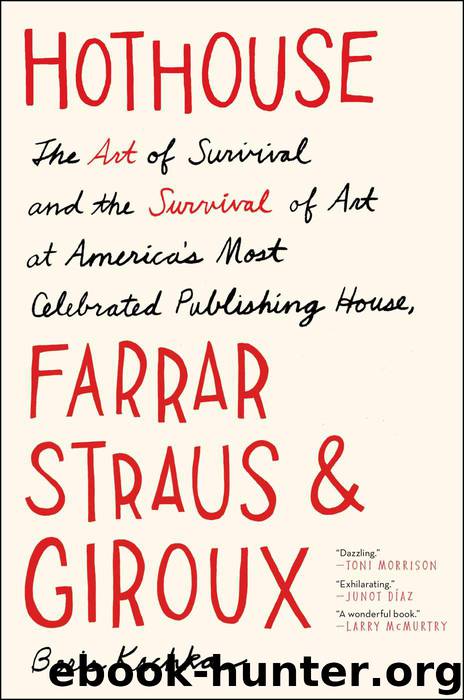Hothouse: The Art of Survival and the Survival of Art at America's Most Celebrated Publishing House, Farrar, Straus, and Giroux by Boris Kachka

Author:Boris Kachka [Kachka, Boris]
Language: eng
Format: mobi
Publisher: Simon & Schuster
Published: 2013-08-05T14:00:00+00:00
10
A Fraught Summer
In June 1984, Roger Straus spent a long week at Memorial Sloan-Kettering Cancer Center, waiting for test results on a malignant tumor in his colon, wondering if he’d make it to seventy. And that wasn’t even the worst of it. His son, deposed from his job as editorial director of Harper & Row, was licking his wounds at Times Books. His “illegitimate son,” David Rieff, was recovering from a nervous breakdown. His editorial department was—he had to admit it—flailing. Even FSG’s supposed “friends” abroad were selling T. S. Eliot’s letters not to Bob Giroux but to “this Serb,” William Jovanovich.
The vultures were beginning to circle over Union Square. “The Dwarf,” S. I. Newhouse, Roger’s onetime neighbor on 70th Street and now the proud owner of Random House, was calling Peggy at the office, ostensibly to ask after Roger’s health. He’d already ruined Gourmet, cofounded by Roger’s mother, Gladys Guggenheim, by “putting fucking tampon ads in it.” Then he’d wreaked havoc at Vanity Fair (and would buy 17 percent of The New Yorker’s stock that fall). And now he was salivating over Roger’s prostrate body. Straus knew what he had to do. He had to ask his son to put aside his independent notions and come home. At the hospital, Rog refused to commit. Mostly, they spoke about his father’s prognosis. “I’m dying,” said Roger. “You’ll live forever,” Rog replied with a laugh. “It turns out we were both wrong,” Rog says now.
Just after Straus was diagnosed with cancer, the first installment of Tom Wolfe’s decades-delayed novel-in-progress came out in Rolling Stone magazine. The eighties, the real subject of The Bonfire of the Vanities, were custom-made for Wolfe’s candy-colored satire. His ambition was Dickensian both in its broad scope (justice, class, race) and in its form (a year’s serialization in a splashy magazine). Also like Dickens, he relied on contrast and counterpoint—black vs. white, rich vs. poor, selfishness vs. the common good. He probably would have cribbed the opening of A Tale of Two Cities if it weren’t so well-known. The eighties were the best of decades and the worst; it was Morning in America; it was the Age of Greed . . . and so forth and so on. Farrar, Straus, too, was conflicted. But where the eighties are said to have been materially rich but artistically impoverished, FSG had the opposite dilemma.
It was, on the one hand, the era of Nobel Prizes. From Isaac Bashevis Singer’s Stockholm trip in 1978 to Seamus Heaney’s in 1995, FSG published the work of ten out of the eighteen winners, an almost unthinkable market share for a house of any size. Two years after foreign publishers had mobbed Roger’s Frankfurt booth in pursuit of Singer, they lined up to ask about Czesław Miłosz, the 1980 Nobelist, a Lithuanian-American poet writing in Polish. Ecco Press held the rights to his poetry, but FSG had managed to grab his fiction, beginning with his 1955 novel The Issa Valley.
Straus, Sontag, their European friends, and
Download
This site does not store any files on its server. We only index and link to content provided by other sites. Please contact the content providers to delete copyright contents if any and email us, we'll remove relevant links or contents immediately.
Nudge - Improving Decisions about Health, Wealth, and Happiness by Thaler Sunstein(7247)
Deep Work by Cal Newport(6565)
Principles: Life and Work by Ray Dalio(5972)
The Doodle Revolution by Sunni Brown(4506)
Factfulness: Ten Reasons We're Wrong About the World – and Why Things Are Better Than You Think by Hans Rosling(4490)
Eat That Frog! by Brian Tracy(4153)
Thinking in Bets by Annie Duke(3999)
Hyperfocus by Chris Bailey(3909)
Visual Intelligence by Amy E. Herman(3623)
Writing Your Dissertation in Fifteen Minutes a Day by Joan Bolker(3576)
How to Win Friends and Influence People in the Digital Age by Dale Carnegie & Associates(3368)
Ogilvy on Advertising by David Ogilvy(3338)
Hidden Persuasion: 33 psychological influence techniques in advertising by Marc Andrews & Matthijs van Leeuwen & Rick van Baaren(3293)
How to win friends and influence people by Dale Carnegie(3272)
The Pixar Touch by David A. Price(3211)
Schaum's Quick Guide to Writing Great Short Stories by Margaret Lucke(3189)
Deep Work: Rules for Focused Success in a Distracted World by Cal Newport(2981)
Work Clean by Dan Charnas(2896)
The Slow Fix: Solve Problems, Work Smarter, and Live Better In a World Addicted to Speed by Carl Honore(2838)
